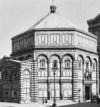- baptistery
-
/bap"teuh stree, -tis teuh ree/, n., pl. baptisteries.1. a building or a part of a church in which baptism is administered.2. (esp. in Baptist churches) a tank for administering baptism by immersion.[1425-75; < LL baptisterium < Gk baptistérion bathing place (see BAPTIST, -ERY); r. late ME baptizatory < ML baptizatorium]
* * *
or baptistryDomed hall or chapel, adjacent to or part of a church, for the administration of baptism.By the 4th century, the baptistery had assumed an eight-sided shape (eight in Christian numerology being the symbol for a new life), as had the baptismal font within. The font itself was set beneath a dome-shaped baldachin and encircled by columns and an ambulatory (aisle), features first used by the Byzantines. Battistero (baptistery) San. Giovanni, Florence, begun 7th centuryAlinari-Art Resource
Battistero (baptistery) San. Giovanni, Florence, begun 7th centuryAlinari-Art Resource* * *
hall or chapel situated close to, or connected with, a church, in which the sacrament of baptism is administered. The form of the baptistery originally evolved from small, circular Roman buildings that were designated for religious purposes (e.g., the Temple of Venus, Baalbek, Lebanon, AD 273, and the Mausoleum of Diocletian, Spalato [Split, Croatia], AD 300); but because baptism originally was performed on only three holidays, Easter, Pentecost, and Epiphany, enlargement of the older Roman buildings became necessary to accommodate the growing numbers of converts.Baptisteries were among the most symbolic of all Christian architectural forms; and the characteristic design that was developed by the 4th century AD can be seen today in what is probably the earliest extant example, the baptistery of the Lateran palace in Rome, built by Sixtus III, pope between 432 and 440.The baptistery was commonly octagonal in plan, a visual metaphor for the number eight, which symbolized in Christian numerology a new beginning. As eight follows the “complete” number, seven, so the beginning of the Christian life follows baptism. Customarily, a baptistery was roofed with a dome, the symbol of the heavenly realm toward which the Christian progresses after the first step of baptism. The baptismal font was usually octagonal, set beneath a domical ciborium, or canopy, and encircled by columns and an ambulatory—features that were first used in the baptistery by the Byzantines when they altered Roman structures.Baptisteries commonly adjoined the atrium, or forecourt, of the church and were often large and richly decorated, such as those at Pisa, Florence, Parma, and Nocera in Italy; el Kantara, Alg.; and Poitiers, France. After the 6th century they were gradually reduced to the status of small chapels inside churches. In the 10th century, when baptism by affusion (pouring liquid over the head) became standard practice in the church, baptisteries, or baptismal chapels, were often omitted entirely.In most modern churches the font alone serves for baptism; something of earlier symbolism survives, however, in its usual location near the church door—an allusion to entering the Christian life.* * *
Universalium. 2010.
